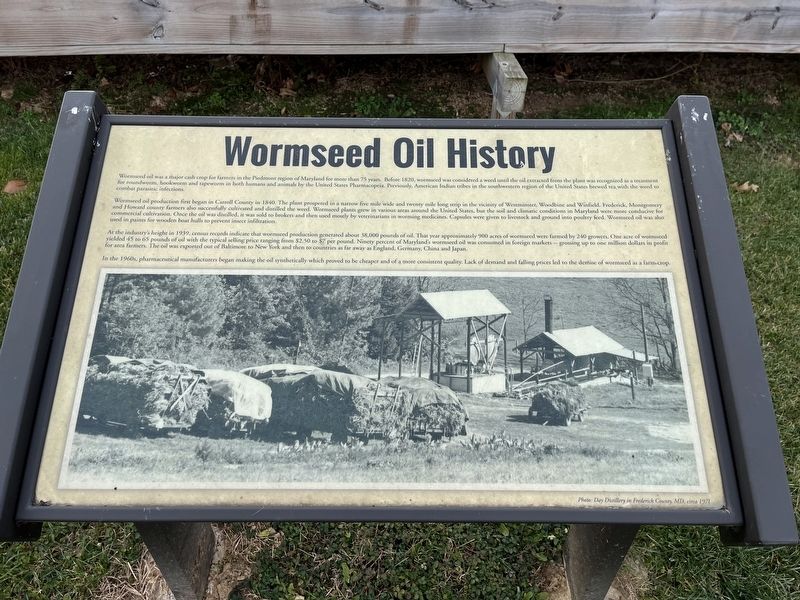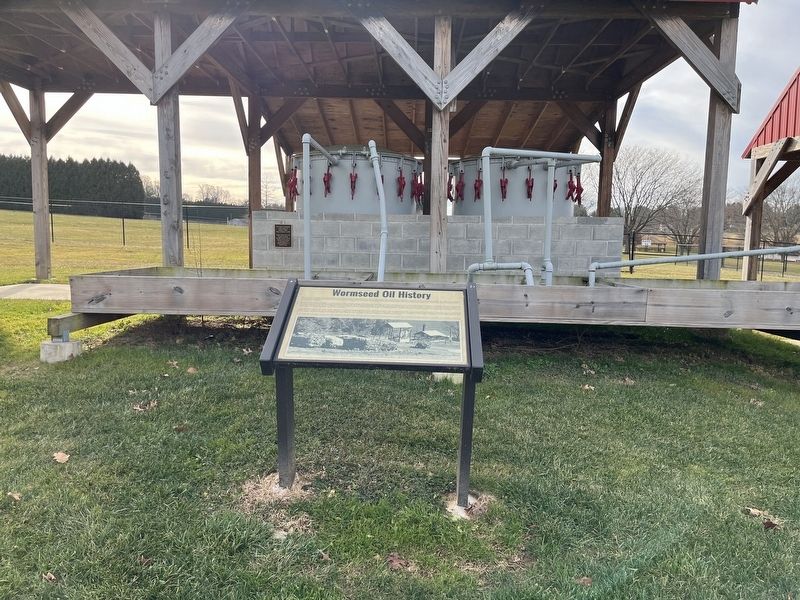Westminster in Carroll County, Maryland — The American Northeast (Mid-Atlantic)
Wormseed Oil History
Wormseed oil was a major cash crop for farmers in the Piedmont region of Maryland for more than 75 years. Before 1820 wormseed was considered a weed until the oil extracted from the plant was recognized as a treatment for roundworm, hookworm and tapeworm in both humans and animals by the United States Pharmacopeia. Previously, American Indian tribes in the southwestern region of the United States brewed tea, with the weed to combat parasitic infections.
Wormseed oil production first began in Carroll County in 1840. The plant prospered in a narrow five mile wide and twenty mile long strip in the vicinity of Westminster, Woodbine and Winfield. Frederick, Montgomery and Howard county farmers also successfully cultivated and distilled the weed. Wormseed plants grew in various areas around the United States, but the soil and climatic conditions in Maryland were more conductive for commercial cultivation. Once the oil was distilled, it was sold to brokers and then used mostly by veterinarians in worming medicines. Capsules were given to livestock and ground into poultry feed. Wormseed oil was also used in paints for wooden boat hulls to prevent insect infiltration.
At the industry's height in 1939, census records indicate that wormseed production generated about 38,000 pounds of oil. Tat year approximately 900 acres of wormseed were farmed by 240 growers. One acre of wormseed yielded 45 to 65 pounds of oil with the typical selling price ranging from $2.50 to $7 per pound. Ninety percent of Maryland's wormseed oil was consumed in foreign markets -- grossing up to one million dollars in profit for area farmers. The oil was exported out of Baltimore to New York and then to countries as far away as England, Germany, China and Japan.
In the 1960s, pharmaceutical manufactures began making the oil synthetically which proved to be cheaper and of a more consistent quality. Lack of demand and falling prices led to the demise of wormseed as a farm-crop.
Erected by Carroll County Farm Museum.
Topics. This historical marker is listed in these topic lists: Agriculture • Anthropology & Archaeology • Industry & Commerce • Native Americans • Waterways & Vessels. A significant historical year for this entry is 1820.
Location. 39° 33.506′ N, 76° 59.591′ W. Marker is in Westminster, Maryland, in Carroll County. Marker is on Farm Museum Road, 0.2 miles south of South Center Street, on the left when traveling south. Touch for map. Marker is at or near this postal address: 500 S Center St, Westminster MD 21157, United States of America. Touch for directions.
Other nearby markers. At least 8 other markers are within walking distance of this marker. Edwin E. Magin (here, next to this marker); 1930s Farm F12 Tractor
Credits. This page was last revised on December 18, 2021. It was originally submitted on December 18, 2021, by Devry Becker Jones of Washington, District of Columbia. This page has been viewed 153 times since then and 19 times this year. Photos: 1, 2. submitted on December 18, 2021, by Devry Becker Jones of Washington, District of Columbia.

